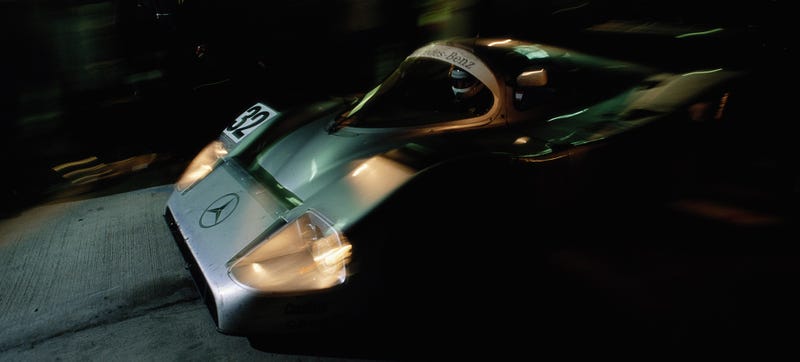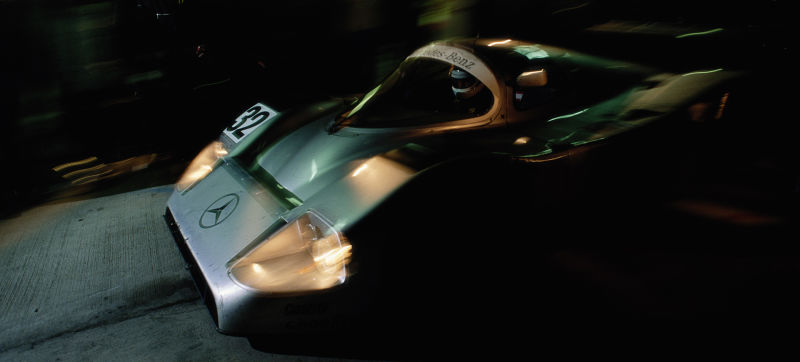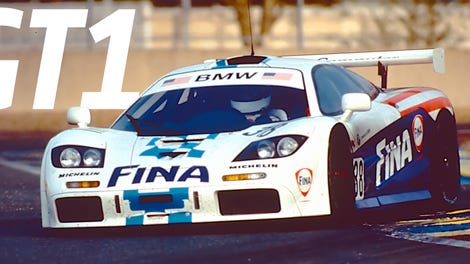
Group C was one of the greatest eras in racing history, producing the fastest cars to ever run the legendary 24 Hours of Le Mans. The story of how it died was, sadly, one that it should have seen coming.
Advertisement
As I said, Group C was one of the greatest eras in racing, possibly an equal to the classic Ford versus Ferrari, Ferrari versus Porsche battles of the 1960s. What’s odd is that both eras died the same way.
Back in the early ‘70s, the organizers at Le Mans became concerned that the big 5.0 liter Porsche 917s and Ferrari 512s competing for overall wins were getting too fast, so they agreed that they would limit engine size to 3.0 liters. By no accident, this was also the same size that engines were allowed to be in Formula 1 at the time. The cars that competed at Le Mans shared their engine designs with the top single seaters of the era. While Ferrari and Porsche etched themselves into history fighting against each other in 1970 and ‘71, Ferrari and the French Matra duked it out in ‘72 and ‘73 using their F1-style engines. These later cars were never as fast or as legendary as the 5.0 liter cars that preceded them. The little 3.0 liter cars, however, were as much if not more complicated and expensive as the cars they replaced. After ‘73, Le Mans sort of entered a strange era of slower racing, fewer cars and fewer fans. Lots of weird cars won in this era in the absence of big name, big budget programs. For the first time a car without a major manufacturer supporting it won, Mirage, and a few years later a local dude named Rondeau won in a car he himself designed. Porsche won once not with a prototype, but with a 911-based turbo 935. It was a weird time. Only Group C in the early ‘80s picked things back up.
Advertisement
You’d think that the organizers at Le Mans would have learned from their past, but by the time the early ‘90s rolled around, they went right back and made their same mistakes all over again.
Porsche had lucked into a winning formula with the twin-turbo 956/962, the first successful prototype cars to use ground effects. Porsche didn’t exactly understand how it all worked, but it knew it did work, and Porsche flooded Group C entry lists with privateer and factory-backed cars, dominating much of the Group C era. Porsche squashed everything in its path until Jaguar got its act together at the end of the decade. Even then, old Porsche 962s that had been around for years remained durable and reliable high-placed finishers.
For 1991, the rules changed and made the turbo Porsches obsolete. No longer could teams run turbocharged cars. Instead they had to run naturally aspirated engines with a maximum displacement of 3.5 liters. There weren’t many other restrictions on the design, and teams could choose anything from six to 12 cylinders and go from there. This just so happened to be the same set of standards as found in Formula 1 at the time. Sound familiar? I think you can see where this is going.
Now, 1991 was a transition year that only gave weight and qualifying penalties to old-spec cars. This was how Mazda loopholed its way into a rotary engine win at Le Mans that year.
From 1992 and on, though, cars competing in the World Sportscar Championship had to use what F1-spec engines to compete. As you might imagine, this was not cheap.
Advertisement
Sponsored
While top spec cars of the Group C era often used engines that had roots in road car designs, like Jaguar’s big V12s or Mercedes’ turbo versions of ordinary V8s, these F1-style engines had to get built up from scratch. Only major manufacturers could afford to design these motors, and privateer teams used to buying up affordable old Porsches and running to respectable finishes got left out entirely.
Before I go on in this discussion of economics and decision making processes, I have to geek out and say holy shitfuck were these engines amazing.
Toyota’s TS010 (pictured above at Le Mans ‘92) had a 50-valve V10 that redlined at a mind-numbing 13,000 RPM. Remember that this was a car that raced and podiumed at the 24 Hours of Le Mans. The stress on the engine must have been massive. The stress on a driver’s ears must have been destructive. Not only were these cars share F1 engine strategies, they shared F1 engine sounds. Listen to the TS010 in testing in 1992.
I will note that this car was cornering at 195 miles per hour, with so much downforce and grip that one test driver is said to have cracked two ribs going flat out over a bump.
Peugeot was the dominant team of this era, and its V10 was famous for wailing like an F1 car.
These were also painfully beautiful cars. The Peugeot 905, often running a biplane rear wing, is particularly close to my heart.
So too is the pink-and-purple Jaguar XJR-14, a project from Gordon Murray of McLaren F1 fame.
The XJR-14 was later sold to Mazda, which put a Judd V10 in it and somehow made it look even more gorgeous.
No top-level prototype has been as clean or as sleek in the years since.
Neither has any produced the raw aerodynamic figures of these cars either. These sports prototypes would produce some 10,000 pounds of downforce at anything over 200 miles per hour.
These were limit-pushing vehicles, genuine greats.
Several other factory teams built highly advanced engines and chassis under these rules. Nissan built its own V12 for an all-carbon car that the collapse of the Japanese economy killed before it ever made it to Le Mans .
TWR and Jaguar built their aforementioned XJR-14 around an detuned but existent Ford F1 V8 that was quickly orphaned, living on as first a Mazda, then as a double-Le-Mans-winning TWR-Porsche.
For 1991, Mercedes designed its first from-the-ground-up racing engine since the 1950s, a 180-degree ‘flat’ 12, which it raced for only a year.
The series never made it past 1992. I don’t mean that this particular formula alone ended after the 1992 season. The World Sportscar Championship itself, which had been running continuously since 1953, ended.
Advertisement
Advertisement
The problem was that there just weren’t enough cars running in 1992 to justify a 1993 season. Porsche had been pushed out years before, Mercedes left for F1, as did Jaguar, as did Peugeot a year later. Bernie Ecclestone, the then-head of the FIA, actually announced that the championship would die before the 1992 season even started, but was persuaded to reverse his decree not long later, as racing photographer John Brooks remembered.
It’s easy to understand why: using F1 engines and F1-style car designs had made Le Mans racing programs as expensive as running a full team in Formula 1, only F1 had more races and significantly more exposure than sports car racing. One F1 team owner of the time explained the consequences of Le Mans’ F1-style rule change in blunt terms:
The rule change was also inspired by the wish to make sports car racing more professional. It gave the impression that at ACO and the CSI they had enough of all those Porsches 962 with their turbocharged engine hanging overall around, for now already ten years. What a lack of respect for such a formidable car! The new rules were not welcomed by the large crowds protesting against them at several occasions, even with large banners. The better initiated motoring enthusiasts, however, didn’t complain about the new rules as they brought several fantastic cars to the tracks allowing spectacular races among top teams. Main question was how the extremely expensive new formula could survive? Despite continuous promises that the races should receive full TV coverage, nothing of that could be made true. If major teams had to make high costs to use F1 equipment, why they should stay with sports car racing rather than making directly the switch to F1 racing receiving worldwide coverage in the press?
In 1989 a complete season of F1 with my Onyx team cost me $16,000,000 for a dozen of races. When in 1991 I spoke in May, at the Silverstone 430-kms, with the guys of Peugeot, Mercedes and Jaguar I heard year budgets oscillating from $10,000,000 to $15,000,000, and this for only eight rounds (one third less than in F1). So, after only three rounds, my conclusion was that it were fantastic cars, better than what ever before was seen in Group C sports car racing, but that it was fully predictable that the new formula could hardly survive during two or three years.
Again, it’s no surprise that everyone left Le Mans for F1. Better exposure for the same cost to the manufacturer is hard to ignore.
Advertisement
The end of the World Sportscar Championship’s 40th and final season was particularly grim, as John Brooks recalled in Speedhunters:
The final indignity was the last SWC round held at Magny Cours. There was a crowd, as Peugoet bussed in most of their workforce from all over France but they only got to see 8 cars. Mazda like everyone else had lost interest in this charade. Two weeks before the race there had been a few lines in a FISA Bulletin “Due to the extremely small number of manufacturers interested in entering, the 1993 Sportscar World Championship has been cancelled.” So it was official this was the end of the road. Forty years of competition was finished.
The destruction of the Endurance Championship was an act of sporting vandalism that was breathtaking in its cynicism, but if you consider the perpetrators and their records it is not a surprise. The aim, which was to get manufacturers into Formula One, worked to an extent, with Mercedes Benz, Toyota, Peugeot and Jaguar all taking that route though only the Germans have enjoyed any real or lasting success.
It was Bernie Ecclestone, Max Mosely and Jean-Marie Ballestre (all infamous figures in the racing world) who were behind the swift change towards F1 regulations, and they were the ones who profited the most from manufacturers moving to F1. They collected F1’s TV money.
But it would be, I think, too much to say that Ecclestone and his accomplices killed Group C. Ultimately, it was the FIA who governed the switch in rules, and it was the FIA who should have known better. After all, they were the ones watching in the ‘70s when they had seen it all happen before.
It’s Ok, GT1 Came Around A Few Years Later
















